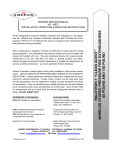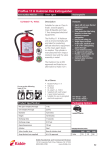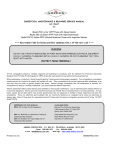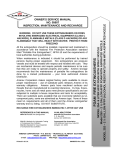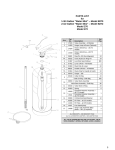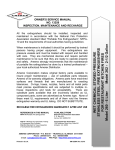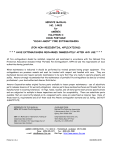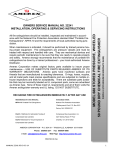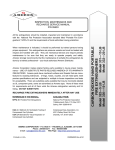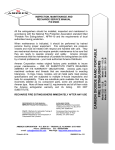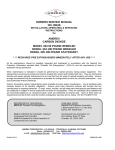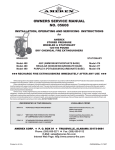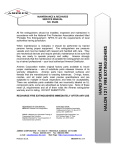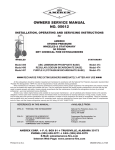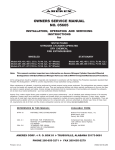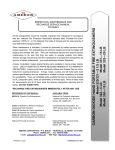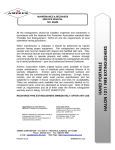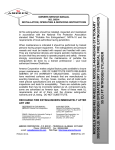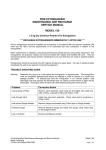Download OWNERS SERVICE MANUAL NO. 16672 INSTALLATION
Transcript
OWNERS SERVICE MANUAL NO. 16672 INSTALLATION, OPERATING & SERVICING INSTRUCTIONS for AMEREX WHEELED STORED PRESSURE HALOTRON l “CLEAN AGENT” FIRE EXTINGUISHERS MODEL 673 - 65 POUND MODEL 674 & 675 - 150 POUND * * * HAVE EXTINGUISHERS RECHARGED IMMEDIATELY AFTER ANY USE * * * All fire extinguishers should be installed, inspected and maintained in accordance with the National Fire Protection Association standard titled "Portable Fire Extinguishers", NFPA-10 and the requirements of local authorities having jurisdiction. When maintenance is indicated it should be performed by trained persons having proper equipment. Fire extinguishers are pressure vessels and must be treated with respect and handled with care. They are mechanical devices and require periodic maintenance to be sure that they are ready to operate properly and safely. Amerex strongly recommends that the maintenance of portable fire extinguishers be done by a trained professional – your local authorized Amerex Distributor. Amerex Corporation makes original factory parts available to insure proper maintenance – use of substitute parts releases Amerex of its warranty obligations. Amerex parts have machined surfaces and threads that are manufactured to exacting tolerances. O-rings, hoses, nozzles, and all metal parts meet precise specifications and are subjected to multiple in-house inspections and tests for acceptability. There are substitute parts available that are incorrectly labeled as UL component parts, some are advertised as Amerex type. None of these meet UL requirements and all of them voids the Amerex extinguisher warranty and UL listing. DO NOT SUBSTITUTE. REFERENCES IN THIS MANUAL: NFPA-10 Portable Fire Extinguishers AVAILABLE FROM: National Fire Protection Association 1 Batterymarch Park, P. O, Box 9101 Quincy, MA 02269-9101 CGA C-1 Methods for Hydrostatic Testing of Compressed Gas Cylinders CGA C-6 Standard for Visual Inspection of Compressed Gas Cylinders Compressed Gas Association, Inc. 4221 Walney Road, 5th Floor Chantilly, VA 20151-2923 AMEREX CORPORATION – P.O. BOX 81 – TRUSSVILLE, ALABAMA 35173-0081 Phone: (205) 655-3271 Fax: (800) 654-5980 Web Page: http://www.amerex-fire.com e-mail: [email protected] Printed in U.S.A. OM16672Rev.12/03 INTRODUCTION This manual covers specific instructions for the Amerex wheeled Models 673 (65 lb., 16” semi-pneumatic wheels), 674 (150 lb., 16” semi-pneumatic wheels), and 675 (150 lb., 36” wide steel wheels) extinguishers. Special maintenance and recharge instructions contained in this manual apply to these extinguishers only. Halotron l “Clean Agent” extinguishers are designed for Class A, B, and C hazards formerly protected with Halon 1211 extinguishers. They contain dichlorotrifluoroethane (R-123), which is designated for streaming fire extinguisher applications. Halotron l is listed in the U.S. Environmental Protection Agency (EPA) “Significant New Alternative Policy” (SNAP) as acceptable for nonresidential applications. Halotron l has acceptable toxicity and cardiac sensitization levels for use in occupied spaces when used according to the instructions on the nameplate and rules of the EPA SNAP Program. PHYSICAL PROPERTIES OF HALOTRON l Primary Component Dichlorotrifluoroethane (R-123) or (HCFC-123) Boiling Point 80.6°F [27°C] Liquid Density 92.3 lb./ft³ (1.48 kg / liter) Gas Density 0.385 lb./ft³ (6.17 kg / m³) Molecular Weight 150.68 Physical State Pressurized Liquid Vapor Pressure @ 68ºF [20ºC] (liquid alone) 11.2 psi [77 kPa] Pressure of mixture in Container @ 68ºF [20º] 95 psig in bulk container HALOTRON l LIMITED WARRANTY Amerex warrants its Halotron l fire extinguishers to be free from defects in material and workmanship for a period on ONE (1) YEAR from the date of purchase or first recharge, whichever comes first. During the warranty period, any such defects will be repaired or the defective extinguisher replaced at Amerex discretion. This warranty does not cover defects resulting from modification, alteration, misuse, exposure to corrosive conditions or improper installation. ALL IMPLIED WARRANTIES, INCLUDING, BUT NOT LIMITED TO, WARRANTIES OF FITNESS FOR PURPOSE AND MERCHANTABILITY, ARE LIMITED TO THE TIME PERIODS AS STATED ABOVE. IN NO EVENT SHALL AMEREX CORPORATION BE LIABLE FOR INCIDENTAL OR CONSEQUENTIAL DAMAGES. Some states do not allow limitations on how long an implied warranty lasts or the exclusion or limitation of incidental or consequential damages, so that the above limitations or exclusions may not apply to you. Amerex Corporation neither assumes nor authorizes any representative or other person to assume for it any obligation or liability other than as expressly set forth herein. This warranty gives you specific legal rights, and you may also have other rights, which vary from state to state. To obtain performance of the obligation of this warranty, write to Amerex Corporation, P.O. Box 81, Trussville, AL 35173-0081 for instructions. Amerex Corporation does not service, maintain or recharge fire extinguishers. The maintenance and recharge portion of this manual is published as a guide to assist service personnel in the inspection, maintenance and recharge of Amerex Halotron l wheeled fire extinguishers only. No instruction manual can anticipate all possible malfunctions that may be encountered in the service of fire extinguishers. Amerex assumes no liability for service, maintenance or recharge of fire extinguishers by publishing this manual. To provide optimum extinguisher reliability, recharging should be performed by persons trained in fire extinguisher maintenance and servicing. This manual should be used as a guide for installing and servicing these Amerex extinguishers. The best place to have your extinguishers serviced and recharged is your "Authorized Amerex Distributor" who has the professional experience and equipment to do it properly. 1 THIS MANUAL IS ATTACHED TO EVERY NEW EXTINGUISHER SHIPPED FROM THE FACTORY. IT CONTAINS VALUABLE INFORMATION WHICH SHOULD BE STUDIED BY EVERYONE WHO WILL USE OR SERVICE THE EXTINGUISHER. THE MANUAL SHOULD BE STORED IN A CONVENIENT LOCATION FOR EASY REFERENCE. PREPARING YOUR NEW EXTINGUISHER FOR USE 1. Remove all wrappings, straps and pallet retaining bolts. 2. Examine the extinguisher for shipping damage. 3. Check to insure that the hose connection at the discharge valve and the nozzle connection to the hose are tight. 4. Check to insure that the nozzle shut-off lever is in the CLOSED position. The pull pin should be installed and the tamper seal intact. 5. Visually inspect t he p r es s u r e g a u g e. The pressure gauge sho u l d b e i n t he green zone. Slight pressure variances in the gauge reading may be found if the extinguisher has been subjected to extremes of heat or cold. High temperatures can cause high gauge readings and low temperatures, low readings. When in doubt, condition the extinguisher to 70ºF (21ºC) for several hours to obtain more accurate pressure gauge readings. 6. The method used to determine proper agent fill is by weighing the extinguisher. The gross weight is marked on each extinguisher nameplate. 7. Record the date the unit is being placed into service on the inspection tag and attach it to the extinguisher. INSTALLATION Do not place this extinguisher close to a potential fire hazard. Amerex recommends a location no less than a 50-foot distance from the hazard while leaving an unobstructed access. Avoid placing it in an extremely hot or cold area. The operational temperature range for this ex t i ng u i s her is –40°F to 120°F (-40°C to 49°C). The extinguisher should be adequately protected if temperatures outside of this range are anticipated. Keep the extinguisher clean and free from dirt, ice, chemicals and any contaminants that may interfere with its proper operation. DO NOT FUNCTIONALLY TEST THIS FIRE EXTINGUISHER. (Testing or any use may cause the extinguisher to gradually lose extinguishing agent over a period of time and make the extinguisher ineffective.) OPERATION WARNING: PERSONS EXPECTED TO USE THIS EXTINGUISHER SHOULD BE MADE AWARE OF THE CONFINED SPACE LIMITATIONS AND TRAINED IN INITIATING ITS OPERATION AND PROPER FIRE FIGHTING TECHNIQUE. THE CONCENTRATED AGENT CAN PRODUCE TOXIC BY-PRODUCTS. AVOID INHALATION OF THESE MATERIALS BY EVACUATING THE CONFINED SPACE. DO NOT USE IN CONFINED SPACES SMALLER THAN THE MINIMUM STATED ON THE EXTINGUISHER LABEL. CAUTION: Persons expected to use this extinguisher should be trained in initiating its operation and in the proper fire fighting technique. "Dry Run" and visual aid training will prepare personnel with the feel for this extinguisher so that the most effective application can be utilized in an emergency situation. The basic operating instructions are contained on the pictogram of every extinguisher. The following elaborates on these instructions: 1. Move the extinguisher to within approximately 50 feet of the fire site. KEEP UPRIGHT. 2 2. Twist and pull ring pin and open cylinder valve by rotating (pulling) the valve lever toward the hose 90°. The hose is now pressurized. 3. Pull nozzle with nozzle lever in the closed position from the nozzle mount and extend hose from the storage rack. 4. Stand back 30 feet from the fire and aim just in front of the base of the flames nearest you. 5. Hold hose and nozzle firmly and be prepared for a discharge recoil. Open nozzle by pulling lever toward you. Slowly sweep side to side extending the discharge beyond the edges of the fire. Progressively follow up until the fire is extinguished. Work the fire away from you while being alert for flashbacks. Move closer as the fire is extinguished but not so close as to scatter or splash the burning material. Shut off nozzle lever to stop discharge. Stand and watch for possible re-ignition. 6. Evacuate and ventilate the area immediately after extinguishing the fire. The fumes and smoke from any fire may be hazardous and can be deadly. WARNING: SYMPTOMS OF OVER-EXPOSURE TO PURE HALOTRON l MAY CAUSE CENTRAL NERVOUS SYSTEM EFFECTS SUCH AS DIZZINESS, DROWSINESS, ANESTHESIA, OR UNCONSCIOUSNESS. PERSONS SUFFERING FROM OVER-EXPOSURE SHOULD BE IMMEDIATELY REMOVED TO AREA WITH FRESH AIR. APPLY ARTIFICAL RESPIRATION IF NECESSARY. CONTACT A PHYSICIAN. Discharge Time (approx.) Range (Agent Thow) Hose Length MODEL 673 22 seconds 30 to 45 feet 50 feet MODEL 674 38 seconds 30 to 45 feet 50 feet MODEL 675 38 seconds 30 to 45 feet 50 feet BEFORE PREPARING TO MOVE THE EXTINGUISHER TO THE RECHARGE LOCATION, DETERMINATION MUST BE MADE THAT THE FIRE IS COMPLETELY EXTINGUISHED AND THERE IS NO DANGER OF A FLASHBACK. SHUTDOWN 1. Close the discharge hose valve. Rotate cylinder discharge valve lever 90° to the CLOSED position. 2. Locate the extinguisher in an open area where blow down can be accomplished safely. 3. Tip the extinguisher to rest the carriage handle/tow loop on the ground. Slowly open the discharge hose valve and cylinder valve. Be prepared for some chemical discharge. Relieve all pressure in the cylinder and clear the discharge hose of all Halotron l. To prevent any loss of remaining agent, the carriage handle/tow loop should be positioned as low as possible in a plane below the bottom on the cylinder. CAUTION: DO NOT LEAVE HALOTRON l IN THE HOSE AS OVER-PRESSURIZATION AND DETERIORATION OF THE HOSE MAY OCCUR. 4. When the hose is empty, push the discharge hose valve nozzle lever and cylinder valve lever to the CLOSED positions. 5. Return the extinguisher to an upright position. Coil the extinguisher hose onto the storage rack and position the nozzle onto the mount in preparation for transport to the recharge location. RECHARGE FIRE EXTINGUISHERS IMMEDIATELY AFTER ANY USE 3 INSPECTING THE EXTINGUISHER INSPECTION [NFPA-10 3.3.10 (2002)] is a "quick check" that a fire extinguisher is available and is in operating condition. It is intended to give reasonable assurance that the fire extinguisher is fully charged. This is done by verifying that it is in its designated place, that it has not been actuated or tampered with, and that there is no obvious physical damage or condition to prevent its operation. PERIODIC INSPECTION PROCEDURES (monthly or more often if circumstances dictate) [NFPA-10 6.2.2 (2002)] Periodic inspection of fire extinguishers shall include a check of at least the following items: 1. 2. 3. 4. 5. 6. 7. 8. 9. 10. Location in designated place No obstruction to access or visibility Operating instructions on nameplate legible and facing outward Seals and tamper indicators not broken or missing Determine fullness by weighing Examination for obvious physical damage, corrosion, leakage, or clogged nozzle Pressure gauge reading in the operable range Hose properly coiled and shut-off nozzle in its mount in closed position Condition of tires/wheels and that they rotate freely HMIS label in place MAINTENANCE (At least once a year or when specifically indicated by an inspection.) Maintenance [NFPA 10 3.3.18 (2002)] is a thorough examination of the fire extinguisher. It is intended to give maximum assurance that a fire extinguisher will operate effectively and safely. It includes a thorough examination for physical damage or condition to prevent its operation and any necessary repair or replacement. It will normally reveal if hydrostatic testing or internal maintenance is required. MAINTENANCE PROCEDURE 1. Clean extinguisher to remove dirt, grease or foreign material. Check to make sure that the instruction nameplate and UL manifest are securely fastened and legible. Inspect the cylinder for corrosion, abrasion, and dents or weld damage. If any of these conditions are found and you doubt the integrity of the cylinder, hydrostatically test to factory test pressure, using the proof pressure method in accordance with CGA C-6 and NFPA 10. NOTE: When cleaning avoid use of solvents around the pressure gauge. They could seriously damage the plastic gauge face. 2. Inspect the extinguisher for damaged, missing or substitute parts. Only factory replacement parts are approved for use on Amerex fire extinguishers. 3. Weigh extinguisher and compare with weight printed in the Maintenance section on the nameplate. Recharge extinguisher if weight is not within indicated allowable tolerances. 4. Check the date of manufacture stamped into the cylinder. Cylinder must be hydrostatically (proof pressure) tested every 12 years to the test pressure indicated on the nameplate. Model 673, 65 lb. = 480 psi (3309 kPa); Models 674 and 675, 150 lb. = 1000 psi (6895 kPa). 4 5. Visually inspect the pressure gauge: a. if bent, damaged or improper gauge, depressurize and replace b. if pressure is low or high and temperature/pressure relationship has been ruled out: 1. low pressure – check for leaks 2. high pressure (over pressurized or over charged) depressurize and recharge extinguisher following instructions listed below 6. Remove and check ring pin for freedom of movement. Replace if bent or if removal appears difficult. 7. Check the nozzle shutoff lever for freedom of movement (open and close several times). If the operation is impeded, replace ball valve assembly. Make sure that the nozzle tip is clear and unobstructed. WARNING: ALWAYS OPEN THE SHUTOFF NOZZLE HANDLE SLOWLY. BE PREPARED FOR A POSSIBLE DISCHARGE AND NOZZLE RECOIL. 8. After making sure that there is no residual pressure in the discharge hose, disconnect it from the cylinder operating valve. Blow air through the hose and nozzle assembly to insure that the passage is clear of foreign material. Check the couplings, hose and hose gasket for damage or deterioration – replace as necessary. 9. Inspect valve assembly for corrosion or damage to hose thread connection. Valve removal and/or valve part replacement should be made only after following the depressurizing and recovery procedures listed in the Complete Maintenance procedures. 10. Inspect the wheels to insure they rotate freely. Lubricate as required. 11. Check carriage assembly for loose nuts, bolts, frame distortion or damage. Check welds for damage or corrosion. Replace damaged parts or make repairs as necessary. 12. Reconnect the hose to the agent cylinder. Properly coil the hose on the rack and install the nozzle (with the lever in a closed position) on the mount. NOTE: When assembling the hose to the agent cylinder or nozzle to the hose, tighten the coupling ¼ turn after contacting the hose gasket. 13. Install new tamper seal and record service data on the extinguisher inspection tag. 14. If the extinguisher has been moved to perform service, make sure that it is returned to its proper location. COMPLETE MAINTENANCE (SIX YEAR MAINTENANCE) Six Year Maintenance [NFPA-10 6.3.3 (2002)]. Every 6 years, stored-pressure fire extinguishers that require a 12 year hydrostatic test shall be emptied and subjected to the applicable maintenance procedures. When the applicable maintenance procedures are performed during the periodic recharging or hydrostatic testing, the 6-year requirement shall begin from that date. a. WARNING Before attempting to devalve the extinguisher for maintenance, hydrotest or recharging be sure that it is completely depressurized. Recover agent and vapor according to the instructions below. b. Never have any part of your body over the extinguisher while removing the valve assembly. c. Prolonged exposure of a devalved cylinder to ambient air should be avoided to prevent moisture contamination and cylinder rusting. 5 COMPLETE MAINTENANCE (SIX YEAR MAINTENANCE) PROCEDURES 1. Complete items 1 through 11 in Maintenance Procedure above. 2. Attach the appropriate recharge adapter (P/N 09857) to the extinguisher operating valve on the extinguisher cylinder. Empty the extinguisher of all pressure and Halotron l using an Amerex P/N 14538 Halotron l Recharge Kit and a bulk Halotron l supply cylinder with sufficient empty capacity to accept the contents of the extinguisher. 3. When extinguisher is empty of all agent and pressure, remove valve assembly and disassemble by removing downtube, spring and valve stem assembly. Discard valve stem assembly and collar o-ring. NOTE: Keep cylinder opening covered while devalved to minimize interior corrosion. 4. Thoroughly clean all parts of the disassembled valve with a soft bristle brush or soft cloth. Blow the valve out with dry nitrogen. 5. Install a NEW valve stem assembly (GREEN SEAL) after lightly lubricating the valve stem o-ring with Visilox 728 (do not lubricate the valve stem seal). Reassemble the spring and downtube. Carefully install a NEW collar o-ring (GREEN) which has been lightly lubricated with Visilox 728. Set the valve assembly aside. 6. Inspect the cylinder interior following CGA Visual Inspection Standard C-6. If a hydrotest has been performed or any moisture is evident, the cylinder should be immediately warm air dried. 7. Clean the o-ring seating groove in the cylinder neck. If any rust is evident, remove by using a fine emery cloth (200 grit). Clean the surface and lubricate the entire sealing area with a thin film of Visilox 728. Install the valve assembly in extinguisher cylinder. Hand tighten firmly. 8. Complete the Recharge steps, items 2 through 11. RECHARGE RECHARGING [NFPA-10 3.3.21 (2002)] is the replacement of the extinguishing agent (also includes the expellant for this type of extinguisher). WARNING: a. b. c. Halotron l service should be performed only in a well ventilated room by a properly trained service technician wearing proper eye protection and rubber gloves. Before attempting to recharge be sure this extinguisher is completely depressurized by slowly and carefully depressing the operating lever and discharging the extinguisher into a proper collection area. Use a REGULATED pressurizing source of ultra high purity ARGON ONLY. Set the regulator to no more than 25 PSI higher than the extinguisher gauge operating pressure. 6 d. e. Check and calibrate regulator gauge at frequent intervals. The regulator gauge should be used to determine when the intended charging pressure has been reached. Do not use the extinguisher gauge for this purpose. Never leave an extinguisher connected to a regulator of a high pressure source for an extended period of time. A defective regulator could cause the cylinder to rupture due to excessive pressure. RECHARGING PROCEDURE Note: The following procedure is for an EMPTY Halotron l extinguisher. If you are recharging an extinguisher, which has been partially discharged (with agent remaining in the cylinder) or has been recharged and the pressure leaked, follow the instructions contained in the Recharging Instructions, which is packaged with the Amerex Recharge Kit (P/N 14538). 1. Perform the Complete Maintenance steps 1 through 7. 2. Install the proper Amerex Recharge Adapter and draw a vacuum of 27” of mercury (adjusted for altitude variations) [see your vacuum pump manual for detailed instructions]. 3. Stand the extinguisher upright on a scale of sufficient size and capacity (200 lbs. minimum). Tare weight extinguisher or record empty weight. The extinguisher should be fully discharged and empty. 4. Connect the extinguisher to a Halotron l supply cylinder using the Amerex P/N 14538 Halotron l Recharge Kit. Note: The Halotron l supply cylinder must be pressurized to approximately 100 psi with ARGON to properly charge the extinguisher. 5. Open the agent cylinder discharge valve by pulling 90º toward the hose rack and fill extinguisher to the agent fill weight noted on the nameplate USING ONLY CLEAN UNCONTAMINATED HALOTRON l AGENT. [see detailed instructions on your recharging system] CAUTION: Avoid liquid Halotron l contact with the external extinguisher cylinder. 6. Pressurize to the extinguisher operating pressure with ARGON only. Repeatedly rock the extinguisher to thoroughly mix the ARGON pressurizing gas until proper pressure is reached. Add additional Argon as necessary until the pressure stabilizes. 7. Check extinguisher for leaks at the valve orifice, around the collar seal, and gauge using a Halogen Leak Detector. The alternate method is to apply leak detecting fluid or a solution of soapy water to these areas. Thoroughly remove all leak detection fluid residue using dry nitrogen to blow all liquid residue out of the valve and wipe the extinguisher to dry the exterior. DO NOT LEAVE ANY LIQUID INSIDE THE VALVE BODY. Remove the recharge adapter. CAUTION: If you use a Halogen type leak detector: A residual amount of Halotron l will remain in the valve body until the liquid evaporates. To properly leak test using the Halogen leak detector it is recommended that the extinguisher be set aside a minimum of 24 hours after recharging, then leak tested. 7 8. Install ring pin and new tamper seal. 9. Install hose assembly, with shut-off nozzle attached, to the extinguisher cylinder discharge valve. Tighten hose coupling ¼ turn after contact with hose gasket. Coil hose onto the hose rack and install nozzle into mount. 10. Weigh extinguisher to confirm that the total weight is within the tolerances indicated in the maintenance section on the extinguisher nameplate. 11. Record recharge date and attach new recharge tag in accordance with the requirements of the "Authority Having Jurisdiction". TROUBLE SHOOTING GUIDE WARNING: DETERMINE THE SOURCE OF A LEAK BEFORE THE EXTINGUISHER IS DEPRESSURIZED. THE EXTINGUISHER MUST BE COMPLETELY DEPRESSURIZED BEFORE ANY ATTEMPT IS MADE TO REMOVE THE VALVE ASSEMBLY AND CORRECT THE LEAKAGE PROBLEM. SEE INSTRUCTIONS PACKAGE WITH THE AMEREX HALOTRON l RECHARGE KIT P/N 14538 FOR THE PROPER METHOD OF DEPRESSURIZING THE EXTINGUISHER TO AVOID UNNECESSARY DISCHARGE AND MINIMUM AGENT LOSS. 1. 2. 3. 4. 5. 6. 7. * PROBLEM Pressure gauge reads high or low CORRECTIVE ACTION Pressure variances in the gauge reading may be found if the extinguisher has been subjected to extremes of heat or cold. High temperatures can cause high gauge readings and low temperatures, low readings. When in doubt, condition the extinguisher to 70ºF (21ºC) for several hours to obtain more accurate pressure gauge readings. Leak through valve Remove valve assembly, downtube, spring and valve stem assembly. Install new valve stem (GREEN SEAL) assembly. Check valve seat for scratches or foreign matter. Leak at collar o-ring Remove valve assembly, clean collar o-ring seating surface thoroughly and lubricate lightly with Visilox-728. Install new collar o-ring (GREEN) after lubricating with Visilox V-728. Leak around gauge threads Remove gauge* and reinstall using Teflon tape on the gauge threads. Defective gauge Remove defective gauge* and install a new gauge using Teflon tape on the gauge threads. Leak in cylinder Contact Amerex if under warranty, otherwise mark “REJECTED” and return to owner. Visible deterioration of Replace hose assembly. Extinguishing agent has been stored in hose discharge hose for a prolonged time. See Caution in Shut-Down procedures. Pressure gauge threads are coated with a special epoxy at the factory. For easy removal soak the valve assembly in hot water (180° F/82°C) for two to four minutes. Remove gauge with a 7/16” open end wrench. 8 PARTS LIST For 65 lb. Stored Pressure Halotron 1 Wheeled Extinguishers Model 673 – 16” Semi-Pneumatic Wheels Item No. 1 2 3 4 5 6 Part No. 16661 04938 16724 16690 06130 07481 7 07751 8 9 10 11 12 13 14 15 16 17 18 19 20 21 22 04945 06059 16723 14417 06100 01387 16666 06060 16664 16668 03556 03501 06279 03877 16659 23 05723 24 25 - 05152 09857 06247 NOTE: 9 Description Valve Assembly with Downtube Downtube/Retainer Assembly Carriage Assembly w/o Wheels Hose Support w/hardware Nozzle Mount with Hardware Pictogram Wheel Assembly, 16" with Hubcap, Washer and Retaining Pin, SemiPneumatic Hubcap Valve Lever w/Screws Gauge Guard Assembly 100 PSI Gauge Ring Pin, SS with Wire Tamper Seal (Yellow) Valve Body Cam Assembly w/o-rings Collar O-Ring Valve Stem Assembly Spring Hose Assembly ¾’ X 50’ Ball Valve Assembly Gasket, Hose/Nozzle Nozzle Tip (.395) Hydrotest Adapter (Male Plug). Use with P/N 09857 to test 50 ft. hose assembly Hydrotest Adapter (Cylinder) Recharge Adapter Visilox Lub. (5 oz. tube) Std. Pkg. 1 1 1 1 1 1 1 1 1 1 1 12 500 1 1 24 6 6 1 1 6 1 1 1 1 1 Replacement valve assemblies incude new valve body, gauge, gauge guard, cam lever, valve stem assembly, spring and downtube/retainer assembly. PARTS LIST For 150 lb. STORED PRESSURE HALOTRON 1 Wheeled Extinguishers Model 674 – 16" Semi-Pneumatic Wheels Model 675 – 36" x 6" Wide Steel Wheels Item No. Part No. 1 16677 Valve Assembly with Downtube 1 2 3 4 16726 16727 07481 1 1 1 5 16725 6 07026 6A 07551 7 07389 7A 8 9 10 11 12 13 14 15 16 17 18 19 20 21 04945 06059 16723 14418 06100 01387 06060 16666 16664 16668 16679 03877 06279 16674 03501 22 05723 23 24 - 05152 09857 06247 Downtube/Retainer Assembly Carriage Assembly w/o Wheels Pictogram Hose Support Asy with Mounting Hardware Wheel Asy-36"x6" – Red (675) Wheel Asy–16" w/hubcap, washer & retaining pin – semipneumatic (674) Hubcap (metal) w/washer & Cotter Pin (675) Hubcap (plastic) – (674) Valve Lever w/Screws Gauge Guard Assembly 125 PSI Gauge Ring Pin, SS with Wire Tamper Seal (Yellow) Cam Assembly w/o-rings Valve Body Collar O-Ring Valve Stem Assembly Spring Gasket – Hose/Nozzle Ball Valve Assembly Nozzle Tip (.687) Hose Assembly ¾" x 50' Hydrotest Adapter (Male Plug) Use with P/N 09857 to test 50 ft. Hose Assembly Hydrotest Adapter (Cylinder) Recharge Adapter Visilox Lub. (5 oz. Tube) NOTE: Description Std. Pkg. 1 1 1 1 1 1 1 1 12 500 1 1 12 6 6 6 1 1 1 1 1 1 1 Replacement valve assemblies include new valve body, gauge, gauge guard, cam, lever, valve stem assembly, spring and downtube/retainer assembly 10











